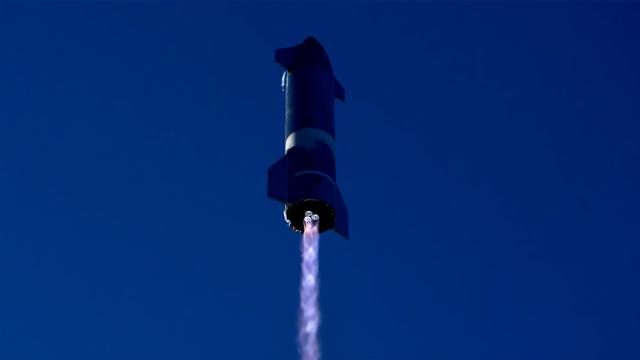SpaceX is ready to conduct a high-altitude flight test of Starship prototype SN9, and our fingers are crossed that it’ll finally happen today. You can watch the action live right here.
The window for today’s launch is already open, and it’s set to close at 11 a.m. AEDT. I wish we could provide you with a firmer estimate for time of launch, but it is what it is. And in fact, today’s launch might not even happen.
That said, the feed from NASASpaceflight (below) has a checklist showing how close SpaceX is to launch, allowing you to keep track of any progress. Once the launch team gets down to Tank Farm Activity, it’ll be about an hour, while the Propellant Loading stage signifies about 10 to 15 minutes before launch.
SpaceX says it’ll provide a live video feed for the SN9 launch, which we will add once it becomes available. In the meantime, or should you prefer alternatives, we have feeds from LabPadre and NASASpaceflight, both of which feature live commentary.
The SpaceX team is attempting its second high-altitude flight test of a Starship prototype; the first one occurred on December 9, 2020. The prototype will launch from the company’s test site in Boca Chica, Texas, and ascend to approximately 10 kilometres. As the rocket approaches apogee, its three Raptor engines will shut down in sequence. SN9 will then perform a propellant switch to prepare for landing and reorient itself for reentry.
SpaceX has been trying to launch SN9 for over a week, but high winds and the inability to procure temporary flight restrictions (TFRs) from the Federal Aviation Administration prevented the company from doing so. The delay may have something to do with the SN8 launch in which, SpaceX violated the FAA licence, according to The Verge. Exactly how SpaceX violated the test flight isn’t known, but the company is now under increased scrutiny.
Naturally, this was of great irritation to SpaceX CEO Elon Musk, who last week tweeted:
Unlike its aircraft division, which is fine, the FAA space division has a fundamentally broken regulatory structure. Their rules are meant for a handful of expendable launches per year from a few government facilities. Under those rules, humanity will never get to Mars.
But the FAA says it’s simply doing its job.
“While we recognise the importance of moving quickly to foster growth and innovation in commercial space, the FAA will not compromise its responsibility to protect public safety,” Steven Kuhn, FAA spokesperson, told SpaceNews late last week. “We will approve the modifications only after we are satisfied that SpaceX has taken the necessary steps to comply with regulatory requirements.”
Which apparently happened. The FAA has granted SpaceX unlimited TFRs from February 2 to 4, according to LabPadre, a group that reports live from the launch site at Boca Chica, Texas.
The delay in launching SN9 has resulted in a pretty cool sight, as the company’s next prototype, SN10, has already been moved to the launch site. This should give you a good indication of the company’s ambitions and the rapid pace at which it’s hoping to test these rockets (prototypes SN11 through to SN17 are also in development).
Starship SN9 & SN10 pic.twitter.com/urtPJn7amo
— Elon Musk (@elonmusk) January 29, 2021
For today’s scheduled test, and after reaching the intended apogee, SN9 will “descend under active aerodynamic control, accomplished by independent movement of two forward and two aft flaps on the vehicle,” according to SpaceX. The rocket’s four flaps, controlled by an onboard computer, work to control the rocket’s orientation during flight and “enable precise landing at the intended location.” The Raptor engines will once again come to life, as “the vehicle attempts a landing flip manoeuvre immediately before touching down on the landing pad adjacent to the launch mount,” per SpaceX.
Watching this gigantic 20-metre tall rocket make a controlled landing would truly be a spectacle. This is the part that didn’t go so smoothly during the SN8 test, with the prototype exploding in an enormous fireball as it struck the ground. Musk seemed unphased by the failed landing, describing the test as a “successful ascent.” The attempted landing of SN9 could go much better, given the lessons from that first test.
[referenced id=”1661756″ url=”https://gizmodo.com.au/2021/01/spacex-will-try-to-catch-its-starship-boosters-instead-of-landing-them/” thumb=”https://gizmodo.com.au/wp-content/uploads/2021/01/05/dy0km7mrz8jwjxuukozr-300×173.png” title=”SpaceX Will Try to ‘Catch’ Its Starship Boosters Instead of Landing Them” excerpt=”Not content to keep things simple or easy, SpaceX plans to catch its upcoming Super Heavy booster rockets at the launch tower, allowing for subsequent relaunches a mere one hour later.”]
For SpaceX, the ability of Starship to successfully perform controlled vertical landings is critical. These landings, combined with in-space refuelling, will allow the rocket to land at “destinations across the solar system where prepared surfaces or runways do not exist, and returning to Earth,” according to SpaceX. The company envisions Starship as a fully reusable transportation system for both crew and cargo, capable of reaching the Moon, Mars, and even more distant destinations.
Starship will eventually come in two versions, either as an independent rocket or as the second stage of a reusable launch system, wherein a Super Heavy booster will serve as the first stage. Musk recently announced that SpaceX will attempt to “catch” the big booster with the launch tower arm and re-launch the vehicle around an hour later.
